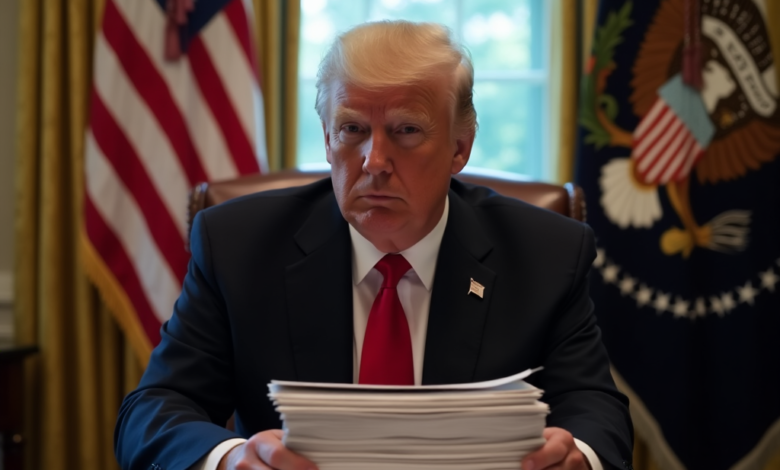
Trump Unveils Massive Day One Executive Order Plan
Donald Trump’s team has revealed plans executive orders that would reshape federal policy dramatically. His first day back in office could see more than 200 executive actions signed immediately. These directives would affect immigration, trade, and government structure extensively. Trump plans to launch “the largest deportation program in American history” while declaring a national emergency along the U.S.-Mexico border. His administration would impose a 60% tariff on Chinese imports and make substantial trade policy changes. The proposed Schedule F policy would transform federal civil service positions fundamentally. Trump’s team also plans to release classified documents about President John F. Kennedy’s assassination. These unprecedented executive actions would mark a dramatic transformation in federal policy if Trump returns to the White House.
Unprecedented Scale of Executive Actions
The incoming administration’s planned executive actions go beyond what recent presidents have done. U.S. presidents have issued 15,902 executive orders over 236 years, which averages 67 per year. Trump’s first term saw 220 executive orders, which surpassed any other president’s four-year term since Jimmy Carter.
Volume comparison with previous presidents
The planned actions reach unprecedented levels compared to recent presidents. Barack Obama signed 276 orders during his eight years, and Joe Biden has issued 160 orders. Trump’s team has already prepared more than 100 executive orders they want to implement right away. Republican Senator John Barrasso describes the upcoming wave as a “blizzard” of executive orders that will “shock and awe”.
Key policy areas targeted
These executive actions focus on several critical areas:
- National security and immigration enforcement
- Energy sector regulations and environmental policy
- Federal workforce restructuring
- Economic and trade measures
The administration plans to declare national emergencies about energy policy and Alaskan resources. The reinstatement of Schedule F will bring major changes to federal employment and affect thousands of civil service positions.
Timeline for implementation
A rapid deployment strategy guides these executive actions. The first wave of orders will begin right after the inauguration, followed by more actions in the coming days and weeks. The White House transition team says they will sign about 50 orders on day one, and this number could grow beyond 100.
Immigration and Border Security Measures
Immigration enforcement leads the new administration’s policy agenda. The Department of Homeland Security will launch what officials call the largest deportation operation in U.S. history.
Mass deportation program details
The administration’s original plan targets about 1.4 million people who have final removal orders. We focused on removing recent border crossers, people with criminal convictions, and those who can’t stay in the United States legally. Immigration and Customs Enforcement (ICE) data shows that Texas and Florida enforcement areas house one-third of these priority targets.
Border emergency declaration
A national emergency declaration at the southern border will allow immediate military deployment. The Defense Department can help with border security operations and wall construction. The plan also has contracts to build detention facilities near the Mexico border.
Legal and logistical challenges
This is a big deal as it means that operational hurdles stand in the way. ICE detention facilities can hold about 40,000 people daily, which isn’t enough for large operations. The complete deportation operations could cost more than AED 1101.58 billion. The administration must work around sanctuary cities where local authorities don’t help federal immigration enforcement.
The program needs more resources to build detention facilities and improve transportation. Private prison companies are putting AED 257.04 million into better housing and monitoring systems. Texas has offered 1,400 acres to build detention facilities. Staffing these facilities is tough since many jails across the country don’t have enough workers.
Economic and Trade Initiatives
The new administration’s life-blood centers on major shifts in U.S. trade and economic policy. The president-elect wants to roll out wide-ranging tariff measures that will affect trading partners of all sizes.
New tariff structure implementation
The new tariff framework targets major trading partners at different rates:
- All imported goods will face a 10-20% tariff
- Chinese imports will see a 60% tariff
- Products from Canada and Mexico will carry a 25% surcharge
These measures should tackle trade deficits and currency practices. The World Bank cautions that such tariffs could cut global economic growth to 2.4% from the projected 2.7% in 2025.
Cryptocurrency policy changes
The administration plans to make cryptocurrency a national priority. Former North Carolina congressional candidate Bo Hines will lead a Presidential Council of Advisers for Digital Assets to guide this initiative. The Treasury Department must create a Strategic Bitcoin Reserve and build up AED 77.11 billion in bitcoin. This builds on the government’s bitcoin holdings of AED 73.44 billion from earlier investigations.
Energy sector deregulation
The energy agenda pushes for expanded fossil fuel production. The plan removes federal land drilling restrictions and lifts offshore drilling bans on Atlantic and Pacific coasts. Former North Dakota Gov. Doug Burgum will head a new National Energy Council to shape energy policy changes. The most important changes remove electric vehicle mandates and restart liquified natural gas export permits. These changes could cut energy costs by half, according to the administration.
Federal Government Restructuring
Federal employment faces major structural changes as the life-blood of the incoming administration’s agenda. Elon Musk and Vivek Ramaswamy will lead the Department of Government Efficiency to implement sweeping reforms among the Office of Management and Budget.
Schedule F reinstatement effect
The administration will bring back Schedule F, a classification that changes federal employees’ policy-related positions. This initiative could affect between 50,000 to hundreds of thousands of federal positions. The Office of Personnel Management created a new rule to stop Schedule F from returning by adding more procedural requirements. All the same, you retain control to repeal this rule through a notice-and-comment process that could take several months.
Department reorganization plans
A detailed restructuring blueprint focuses on streamlining processes and accountability. The Department of Government Efficiency will suggest cuts to federal agencies and bureaucracy. The administration wants to:
- Move agency functions to state or local governments where possible
- Find program overlaps between departments
- Study if agency operations are worth their cost
- Look for ways to combine administrative tasks
Civil service reforms
Civil service reform goes beyond Schedule F changes. The changes include possible limits on telework arrangements and a review of recent collective bargaining agreements. The incoming Office of Management and Budget director plans to cut agency spending and reduce federal workforce numbers. These reforms ended up increasing reliance on government contractors, as data shows contractor positions grew from 4.8 million in 2017 to 6.8 million during the previous administration.
American governance faces a radical alteration with these new executive actions. No recent president has matched the scale of these 200+ executive orders. The administration wants to launch large deportation operations and beef up border security through targeted immigration enforcement.
The economic strategy focuses on tough trade measures. A 60% tariff on Chinese imports and major cryptocurrency plans through the Strategic Bitcoin Reserve lead these efforts. The civil service landscape could change drastically when Schedule F returns. This move might affect thousands of government workers.
Legal, logistical, and administrative capabilities will determine how well these detailed reforms work. Several roadblocks stand in the way. ICE lacks enough detention space. Federal workforce changes pose complex challenges. These bold executive actions might take longer to implement than planned.
These directives could revolutionize federal operations and American society through executive power. Courts will review them. Congress will watch closely. Real-world challenges will test how well they work. The full effect of these changes will take time to understand.




